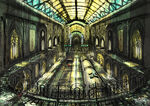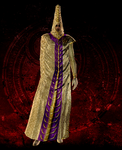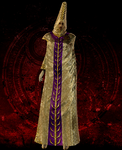Vigrid is the primary setting for Bayonetta as well as a central element to the plot of the story. Dubbed as the "City of Déjà Vu", its stance in the world acts essentially as a city-state in Europe, rather than an urban location in a designated European country. The scenery and urban sprawl are reminiscent of pre-Renaissance era architecture, with roving avenues, ornate vistas, and palatial plazas. The only means of accessing Vigrid is a single rail system, with which Visa permits are extensively enforced. Beneath the city is an extensive network of catacombs whose history is not fully divulged. Later in the game, it is established that Vigrid was more than just a secluded city-state; the entire city was once the fortress stronghold of the covenant of Lumen Sages and Umbra Witches before the civil war that destroyed both dynasties. The city itself is deeply intertwined with Paradiso and sometimes overlaps dimensions to allow the Hierarchy of Laguna to travel on Earth easily.
Though the city has no diplomatic leadership to speak of, it actually does tout a leader (of sorts), being none other than the last surviving Lumen Sage, Father Balder. He is the president of a multi-billion dollar technological conglomerate known as the Ithavoll Group - whose very prominence has maintained Vigrid's immense wealth, self-sustainability and isolationism. He is also the high priest and religious authority of the Ragna religion, an eclectic religion established in Vigrid that worships Jubileus the Creator and encourages its followers to commit mass suicide to have their souls transformed into new Angels.
Areas[]
Central Station/Station Platform[]
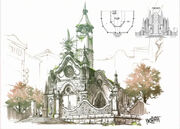
Concept art of Vigrid Church
The central station of Vigrid is the one and only way of entering or exiting Vigrid, built like most European railway station platforms, passengers heading to Vigrid are required to show a Vigrid-issued entry visa at security inspection before they are allowed in. A hidden passage blocked off by a Golem-material wall shows a sewer system and a secret elevator to the Central Station Plaza. In the Central Station exists old temple hallways that lead into a large park area and beautiful cliffside bridge that go further into Vigrid's neighborhood.
Streets[]
The various routes of Vigrid, the streets lead into several large neighborhoods that house Vigrid's population and community areas which include food carts, restaurants and produce stores. Among the outer part of the streets is the cliffsides of the city which gives the residents an incredible view of the ocean and cliffs, on the eastern side of this vista is cut off area that features an old church. Also viewable is the cliff where an ancient coliseum lies. On the western side is a locked door that is eventually used to access a street that leads into a plaza which also holds entry into the catacombs below the city.
Catacombs[]
The Catacombs below Vigrid's surface are large, cavernous areas that are visited during Chapter 3, due to Fortitudo's influence, the underground tombs are bristling with open lava and dangerous explosions, additionally, there are large bridges and a gateway into Paradiso (known as Porta del Paradiso). There is also a vertical tunnel that leads to the ancient coliseum from here.
Proving Ground Ruins/Ruins[]
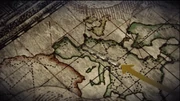
A map showing the general area of Vigrid
Also known as the Ruins of Luna and Sol, these desolate temples as implied by name were the training grounds for Umbra Witches and Lumen Sages visited during Chapter 6. The temple ruins are under control from Vigrid security, who have enclosed initial access. Further within these ruins lies several portals to Paradiso, one of which grants access to the Vigrid Air Force Base.
Air Force Base[]
The immense base west of Vigrid is the state's primary military defense, the hangars house several majestic military jets known as Valkyries that appear to travel from Vigrid to either Isla Del Sol or other locations, Vigrid's generally strict code of conduct does not shy away here. Both Temperantia and Iustitia are fought here at different times.
Church Of Ragna[]
The ornate and resplendent house of worship in Vigrid is the primary location where followers of the Ragna religion gather to proclaim their praises of the Angels of Laguna and prayers in preparation for the resurrection of Jubileus. Inside are stained glass windows detailing the prophecies of their faith and a golden alter by which to say prayers.
Story[]
Bayonetta[]
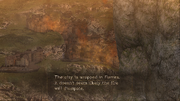
Vigrid's neighborhood burns.
In the first game, Bayonetta travels to the city of Vigrid after learning of information from Enzo about a precious gemstone was put on the black market and quickly retracted. Having traced the stone's origins and feeling it may hold some answers to her forgotten past, Bayonetta travels around the globe to reach the city. Along the way through, she remembers important events from the past relating to her time as an Umbran Witch and eventually learns of the controlling presence of Father Balder on the area in his plan to lure her to the resurrection of Jubileus, The Creator.
In Chapter III, Fortitudo sets Vigrid on fire after Bayonetta attacks him. Bayonetta navigates her way through the now-destroyed town, into the catacombs and up to the Coliseum found on the cliffs above town. Bayonetta takes one more look back at the town, saying the fire is unlikely to go out. The fate of Vigrid and its people is unknown.
In Chapter VI, Bayonetta and Cereza travel through the Proving Ground Ruins, taking several gateways in and out of Paradiso until they arrive at the Vigrid Air Force Base. Bayonetta does battle at the air base with Temperantia in Chapter VII and eventually returns to the base to fight Iustitia in Chapter XI.
Bayonetta 2[]
Vigrid reappears in the sequel when Bayonetta travels into the past around the time of the Witch Hunts. She lands in one of the initial courtyard areas, ruined by the raging war of the time and remarks that she knows where and when she is. It is soon after this that she encounters her mother, Rosa.
Gallery[]
Station[]
Street[]
Catacomb[]
Proving Grounds[]
Air Base[]
Citizens[]
Background[]
- In Norse mythology, Vigrid is a mythical field, which is foretold to host a battle between the gods and Surtr as part of Ragnarok. It is also sometimes referred to as Vígríðr or Óskópnir.
- Vigrid is heavily inspired by Santiago de Compostela, a major christian pilgrimage route located in Galicia in northwestern Spain. The geography of both cities matches perfectly, implying that Vigrid is located in Spain. They are both holy cities.
- Vigrid's architecture draws inspiration from Barcelona, Spain, with some sections resembling Parl Güell.










